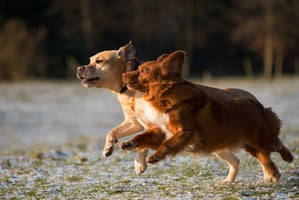Crate training your dog or puppy can be a great way to teach them good behaviour, but it can also...
Understanding Dog Marking Territory: What You Need to Know
Marking territory is a normal part of canine behaviour. It is a way for dogs to communicate with each other and to claim their space. In this article, we will discuss the different ways dogs mark their territory, the reasons why they do it, and how to prevent it.
What is Dog Marking Territory?
Dog marking territory is the act of a dog leaving his or her scent on objects and surfaces, such as trees, furniture, and walls. This is done by urinating, defecating, or scratching. Dogs also mark their territory by rubbing their body against objects or by leaving their saliva on them.
It is important to note that marking territory is not the same as urinating out of excitement or fear. It is a deliberate act with a specific purpose. Marking territory is a way for dogs to communicate with each other and to claim their space.
Why Do Dogs Mark Their Territory?
Dogs mark their territory for a variety of reasons. One of the most common reasons is to inform other dogs of their presence. Dogs can also mark their territory to claim a certain area as their own and to show other dogs that it is off-limits. Marking territory can also be a way for dogs to show dominance over another dog or to show they are the alpha dog in a group.
Another reason why dogs mark their territory is to show other dogs that they are not a threat. This is especially true if the dog is feeling scared or threatened. By marking their territory, dogs are trying to show other dogs that they are not a threat and that they should be left alone.
How to Prevent Dog Marking Territory
The best way to prevent dog marking territory is to provide your dog with plenty of exercise and mental stimulation. Make sure your dog has access to plenty of toys and activities to keep them entertained. Take your dog for regular walks and playtime to keep them physically and mentally active.
It is also important to keep your dog on a regular potty schedule to ensure they are relieving themselves in designated areas. If your dog has access to areas where they are not allowed to mark their territory, keep them away from those areas.
It is also important to provide your dog with plenty of positive reinforcement when they are not marking their territory. Give them treats and praise when they are behaving appropriately. This will help them to understand that marking territory is not acceptable behaviour.
What to Do if Your Dog is Marking Territory
If your dog is marking their territory, the first thing you should do is take them to the vet to rule out any medical conditions. If your dog is healthy, then you need to implement a training program to teach them appropriate behaviour.
Start by establishing a regular potty schedule and sticking to it. Make sure your dog has access to plenty of toys and activities to keep them entertained. If your dog has access to areas where they are not allowed to mark their territory, keep them away from those areas.
It is also important to provide your dog with plenty of positive reinforcement when they are not marking their territory. Give them treats and praise when they are behaving appropriately. This will help them to understand that marking territory is not acceptable behaviour.
If your dog is marking their territory out of fear or anxiety, it is important to address the underlying cause of their behaviour. This could be anything from a lack of socialisation to a traumatic experience. Work with a professional trainer or behaviourist to help your dog overcome their fear or anxiety.
Conclusion
Dog marking territory is a normal part of canine behaviour. It is a way for dogs to communicate with each other and to claim their space. Understanding why dogs mark their territory and how to prevent it can help you keep your home and yard free from unwanted canine scents.
The best way to prevent dog marking territory is to provide your dog with plenty of exercise and mental stimulation. Make sure your dog has access to plenty of toys and activities to keep them entertained. Take your dog for regular walks and playtime to keep them physically and mentally active.
It is also important to provide your dog with plenty of positive reinforcement when they are not marking their territory. Give them treats and praise when they are behaving appropriately. This will help them to understand that marking territory is not acceptable behaviour.
If your dog is marking their territory out of fear or anxiety, it is important to address the underlying cause of their behaviour. Work with a professional trainer or behaviourist to help your dog overcome their fear or anxiety.



